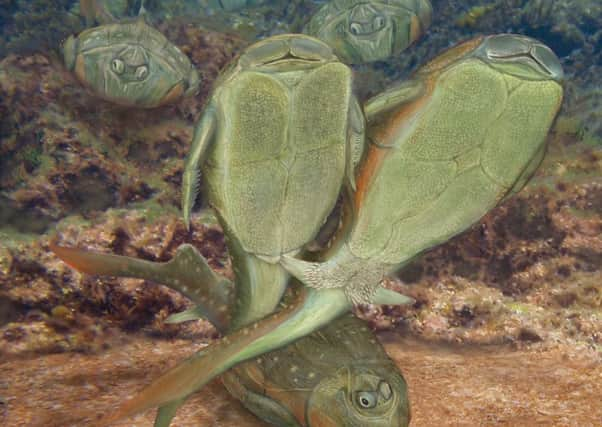Scottish fish ‘invented’ sexual intercourse


The first creatures to use this form of reproduction were the first jawed fish, called Microbrachius dicki.
Microbrachius means “little arms” and refers to the genital limbs that locked male and female fish together when mating.
Advertisement
Hide AdAdvertisement
Hide AdThe three-inch long placoderm – a primitive armoured fish – reproduced in Scottish lochs millions of years before fins evolved into legs.
A study of Microbachius fossils revealed the first evidence of their primitive sexual organs.
To transfer sperm, males had grooved L-shaped claspers which were held in place by small paired bones on the female.
Lead scientist Professor John Long, from Flinders University in Adelaide, Australia, investigated the fossils of a number of placoderms, some dug up in Scotland, which are generally considered to be the most primitive of the jawed fishes.
He said: “Microbrachius means little arms but scientists have been baffled for centuries by what these bony paired arms were actually there for.
“We’ve solved this great mystery because they were there for mating, so that the male could position his claspers into the female genital area.”
Similar copulatory claspers are seen today in some male sharks – but most present-day bony fishes fertilise eggs externally, outside their bodies.
Advertisement
Hide AdAdvertisement
Hide AdThe new discovery implies that external fertilisation evolved from internal fertilisation involving sexual intercourse, and not the other way around.
Microbrachius also seems to have made a head start in trying out interesting sexual positions. According to Prof Long, the fishes probably mated sideways.
“This enabled the males to manoeuvre their genital organs into the right position for mating,” he said. “With their arms interlocked, these fish looked more like they are square dancing the do-se-do rather than mating.”
The discovery, reported in Nature journal’s online edition, highlights the importance of placoderms in vertebrate evolution.
“Placoderms were once thought to be a dead-end group with no live relatives, but recent studies show that our own evolution is deeply rooted in placoderms, and that many of the features we have – such as jaws, teeth and paired limbs – first originated with this group of fishes,” said Prof Long. “Now, we reveal they gave us the intimate act of sexual intercourse as well.”
The fertilisation of eggs by sperm outside the mother’s body was thought to have evolved before copulation.
The process of internal fertilisation and giving birth to live young distinguishes some fish and mammals from other animals, such as reptiles and amphibians.
Placoderms are at the base of the vertebrate tree, so are distantly related to humans. After the placoderms died out, another type of jawed vertebrate, the bony fish, evolved into tetrapods, the four-limbed animal group which includes mammals, birds, reptiles and amphibians.